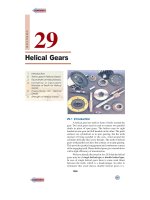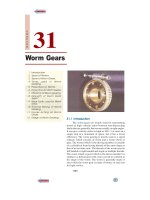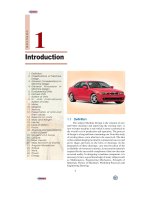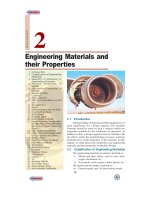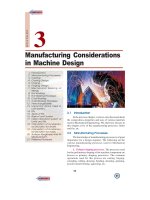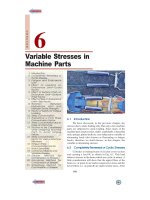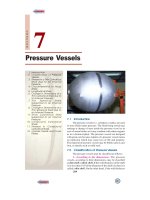Tài liệu Text Book of Machine Design P2 docx
Bạn đang xem bản rút gọn của tài liệu. Xem và tải ngay bản đầy đủ của tài liệu tại đây (421.74 KB, 37 trang )
16
n
A Textbook of Machine Design
2.12.1
2.12.1
2.1
IntrIntr
IntrIntr
Intr
oductionoduction
oductionoduction
oduction
The knowledge of materials and their properties is of
great significance for a design engineer. The machine
elements should be made of such a material which has
properties suitable for the conditions of operation. In
addition to this, a design engineer must be familiar with
the effects which the manufacturing processes and heat
treatment have on the properties of the materials. In this
chapter, we shall discuss the commonly used engineering
materials and their properties in Machine Design.
2.22.2
2.22.2
2.2
Classification of Engineering MaterialsClassification of Engineering Materials
Classification of Engineering MaterialsClassification of Engineering Materials
Classification of Engineering Materials
The engineering materials are mainly classified as :
1. Metals and their alloys, such as iron, steel,
copper, aluminium, etc.
2. Non-metals, such as glass, rubber, plastic, etc.
The metals may be further classified as :
(a) Ferrous metals, and (b) Non-ferrous metals.
Engineering Materials and
their Properties
16
1. Introduction.
2. Classification of Engineering
Materials.
3. Selection of Materials for
Engineering Purposes.
4. Physical Properties of
Metals.
5. Mechanical Properties of
Metals.
6. Ferrous Metals.
7. Cast Iron.
9. Alloy Cast Iron.
10. Effect of Impurities on Cast
Iron.
11. Wrought Iron.
12. Steel.
15. Effect of Impurities on Steel.
16. Free Cutting Steels.
17. Alloy Steels.
19. Stainless Steel.
20. Heat Resisting Steels.
21. Indian Standard Designation
of High Alloy Steels (Stainless
Steel and Heat Resisting
Steel).
22. High Speed Tool Steels.
23. Indian Standard Designation
of High Speed Tool Steel.
24. Spring Steels.
25. Heat Treatment of Steels.
26. Non-ferrous Metals.
27. Aluminium.
28. Aluminium Alloys.
29. Copper.
30. Copper Alloys.
31. Gun Metal.
32. Lead.
33. Tin.
34. Bearing Metals.
35. Zinc Base Alloys.
36. Nickel Base Alloys.
37. Non-metallic Materials.
2
C
H
A
P
T
E
R
CONTENTS
CONTENTS
CONTENTS
CONTENTS
Engineering Materials and their Properties
n
17
* The word ‘ferrous’ is derived from a latin word ‘ferrum’ which means iron.
The *ferrous metals are those which have the
iron as their main constituent, such as cast iron,
wrought iron and steel.
The non-ferrous metals are those which have
a metal other than iron as their main constituent,
such as copper, aluminium, brass, tin, zinc, etc.
2.32.3
2.32.3
2.3
Selection of Materials forSelection of Materials for
Selection of Materials forSelection of Materials for
Selection of Materials for
Engineering PurposesEngineering Purposes
Engineering PurposesEngineering Purposes
Engineering Purposes
The selection of a proper material, for
engineering purposes, is one of the most difficult
problem for the designer. The best material is one
which serve the desired objective at the minimum
cost. The following factors should be considered
while selecting the material :
1. Availability of the materials,
2. Suitability of the materials for the work-
ing conditions in service, and
3. The cost of the materials.
The important properties, which determine the
utility of the material are physical, chemical and mechanical properties. We shall now discuss the
physical and mechanical properties of the material in the following articles.
2.42.4
2.42.4
2.4
PhPh
PhPh
Ph
ysical Prysical Pr
ysical Prysical Pr
ysical Pr
operoper
operoper
oper
ties of Metalsties of Metals
ties of Metalsties of Metals
ties of Metals
The physical properties of the metals include luster, colour, size and shape, density, electric and
thermal conductivity, and melting point. The following table shows the important physical properties
of some pure metals.
A filament of bulb needs a material like tungsten
which can withstand high temperatures without
undergoing deformation.
Copper
Aluminium
Zinc
Iron
Lead
VV
VV
V
aluaalua
aluaalua
alua
ble Metalsble Metals
ble Metalsble Metals
ble Metals
18
n
A Textbook of Machine Design
TT
TT
T
aa
aa
a
ble 2.1.ble 2.1.
ble 2.1.ble 2.1.
ble 2.1.
Ph Ph
Ph Ph
Ph
ysical prysical pr
ysical prysical pr
ysical pr
operoper
operoper
oper
ties of metalsties of metals
ties of metalsties of metals
ties of metals
..
..
.
Metal Density Melting point Thermal Coefficient of
conductivity linear expansion at
(kg/m
3
) (°C) (W/m°C) 20°C (µm/m/°C)
Aluminium 2700 660 220 23.0
Brass 8450 950 130 16.7
Bronze 8730 1040 67 17.3
Cast iron 7250 1300 54.5 9.0
Copper 8900 1083 393.5 16.7
Lead 11 400 327 33.5 29.1
Monel metal 8600 1350 25.2 14.0
Nickel 8900 1453 63.2 12.8
Silver 10 500 960 420 18.9
Steel 7850 1510 50.2 11.1
Tin 7400 232 67 21.4
Tungsten 19 300 3410 201 4.5
Zinc 7200 419 113 33.0
Cobalt 8850 1490 69.2 12.4
Molybdenum 10 200 2650 13 4.8
Vanadium 6000 1750 — 7.75
2.52.5
2.52.5
2.5
Mechanical PrMechanical Pr
Mechanical PrMechanical Pr
Mechanical Pr
operoper
operoper
oper
ties of Metalsties of Metals
ties of Metalsties of Metals
ties of Metals
The mechanical properties of the metals are those which are associated with the ability of the
material to resist mechanical forces and load. These mechanical properties of the metal include strength,
stiffness, elasticity, plasticity, ductility, brittleness, malleability, toughness, resilience, creep and
hardness. We shall now discuss these properties as follows:
1. Strength. It is the ability of a material to resist the externally applied forces without breaking
or yielding. The internal resistance offered by a part to an externally applied force is called *stress.
2. Stiffness. It is the ability of a material to resist deformation under stress. The modulus of
elasticity is the measure of stiffness.
3. Elasticity. It is the property of a material to regain its original shape after deformation when
the external forces are removed. This property is desirable for materials used in tools and machines.
It may be noted that steel is more elastic than rubber.
4. Plasticity. It is property of a material which retains the deformation produced under load
permanently. This property of the material is necessary for forgings, in stamping images on coins and
in ornamental work.
5. Ductility. It is the property of a material enabling it to be drawn into wire with the applica-
tion of a tensile force. A ductile material must be both strong and plastic. The ductility is usually
measured by the terms, percentage elongation and percentage reduction in area. The ductile material
commonly used in engineering practice (in order of diminishing ductility) are mild steel, copper,
aluminium, nickel, zinc, tin and lead.
Note : The ductility of a material is commonly measured by means of percentage elongation and percentage
reduction in area in a tensile test. (Refer Chapter 4, Art. 4.11).
* For further details, refer Chapter 4 on Simple Stresses in Machine Parts.
Engineering Materials and their Properties
n
19
6. Brittleness. It is the property of a material opposite to ductility. It is the property of breaking
of a material with little permanent distortion. Brittle materials when subjected to tensile loads, snap
off without giving any sensible elongation. Cast iron is a brittle material.
7. Malleability. It is a special case of ductility which permits materials to be rolled or hammered
into thin sheets. A malleable material should be plastic but it is not essential to be so strong. The
malleable materials commonly used in engineering practice (in order of diminishing malleability) are
lead, soft steel, wrought iron, copper and aluminium.
8. Toughness. It is the property of a material to resist fracture due to high impact loads like
hammer blows. The toughness of the material decreases when it is heated. It is measured by the
amount of energy that a unit volume of the
material has absorbed after being stressed upto
the point of fracture. This property is desirable
in parts subjected to shock and impact loads.
9. Machinability. It is the property of a
material which refers to a relative case with
which a material can be cut. The machinability
of a material can be measured in a number of
ways such as comparing the tool life for cutting
different materials or thrust required to remove
the material at some given rate or the energy
required to remove a unit volume of the
material. It may be noted that brass can be
easily machined than steel.
10. Resilience. It is the property of a
material to absorb energy and to resist shock
and impact loads. It is measured by the amount
of energy absorbed per unit volume within
elastic limit. This property is essential for
spring materials.
11. Creep. When a part is subjected to
a constant stress at high temperature for a long
period of time, it will undergo a slow and
permanent deformation called creep. This
property is considered in designing internal
combustion engines, boilers and turbines.
12. Fatigue. When a material is
subjected to repeated stresses, it fails at
stresses below the yield point stresses. Such
type of failure of a material is known as
*fatigue. The failure is caused by means of a
progressive crack formation which are usually
fine and of microscopic size. This property is
considered in designing shafts, connecting rods, springs, gears, etc.
13. Hardness. It is a very important property of the metals and has a wide variety of meanings.
It embraces many different properties such as resistance to wear, scratching, deformation and
machinability etc. It also means the ability of a metal to cut another metal. The hardness is usually
Gauge to show the
pressure applied.
Ball is forced into
the surface of the
ordinary steel
Screw to position
sample
BrBr
BrBr
Br
inell inell
inell inell
inell
TT
TT
T
ester :ester :
ester :ester :
ester :
Hardness can be defined as the resis-
tance of a metal to attempts to deform it. This ma-
chine invented by the Swedish metallurgist Johann
August Brinell (1849-1925), measure hardness precisely.
* For further details, refer Chapter 6 (Art. 6.3) on Variable Stresses in Machine Parts.
20
n
A Textbook of Machine Design
expressed in numbers which are dependent on the method of making the test. The hardness of a metal
may be determined by the following tests :
(a) Brinell hardness test,
(b) Rockwell hardness test,
(c) Vickers hardness (also called Diamond Pyramid) test, and
(d) Shore scleroscope.
2.62.6
2.62.6
2.6
FF
FF
F
errerr
errerr
err
ous Metalsous Metals
ous Metalsous Metals
ous Metals
We have already discussed in Art. 2.2 that the ferrous metals are those which have iron as their
main constituent. The ferrous metals commonly used in engineering practice are cast iron, wrought
iron, steels and alloy steels. The principal raw material for all ferrous metals is pig iron which is
obtained by smelting iron ore with coke and limestone, in the blast furnace. The principal iron ores
with their metallic contents are shown in the following table :
TT
TT
T
aa
aa
a
ble 2.2.ble 2.2.
ble 2.2.ble 2.2.
ble 2.2.
Pr Pr
Pr Pr
Pr
incipal irincipal ir
incipal irincipal ir
incipal ir
on oron or
on oron or
on or
eses
eses
es
..
..
.
Iron ore Chemical formula Colour Iron content (%)
Magnetite Fe
2
O
3
Black 72
Haemetite Fe
3
O
4
Red 70
Limonite FeCO
3
Brown 60–65
Siderite Fe
2
O
3
(H
2
O) Brown 48
2.72.7
2.72.7
2.7
Cast IrCast Ir
Cast IrCast Ir
Cast Ir
onon
onon
on
The cast iron is obtained by re-melting pig iron
with coke and limestone in a furnace known as cupola.
It is primarily an alloy of iron and carbon. The carbon
contents in cast iron varies from 1.7 per cent to 4.5 per
cent. It also contains small amounts of silicon,
manganese, phosphorous and sulphur. The carbon in a
cast iron is present in either of the following two forms:
1. Free carbon or graphite, and 2. Combined car-
bon or cementite.
Since the cast iron is a brittle material, therefore,
it cannot be used in those parts of machines which are
subjected to shocks. The properties of cast iron which
make it a valuable material for engineering purposes
are its low cost, good casting characteristics, high
compressive strength, wear resistance and excellent
machinability. The compressive strength of cast iron is
much greater than the tensile strength. Following are
the values of ultimate strength of cast iron :
Tensile strength = 100 to 200 MPa
*
Compressive strength = 400 to 1000 MPa
Shear strength = 120 MPa
* 1MPa = 1MN/m
2
= 1 × 10
6
N/m
2
= 1 N/mm
2
Coke burns to
carbon
monoxide
which releases
the iron from
the ore
Iron ore, coke
and limestone
are loaded into
the furnace
Waste gas
used as fuel
Waste gas
used as fuel
Slag, or
impurities, floats
to the top of the
iron
SmeltingSmelting
SmeltingSmelting
Smelting
: :
: :
:
Ores consist of non-metallic
elements like oxygen or sulphur combined
with the wanted metal. Iron is separated
from the oxygen in its ore heating it with
carbon monoxide derived from coke (a
form of carbon made from coal). Limestone
is added to keep impurities liquid so that the
iron can separate from them.
Engineering Materials and their Properties
n
21
2.82.8
2.82.8
2.8
TT
TT
T
ypes of Cast Irypes of Cast Ir
ypes of Cast Irypes of Cast Ir
ypes of Cast Ir
onon
onon
on
The various types of cast iron in use are discussed as
follows :
1. Grey cast iron. It is an ordinary commercial iron
having the following compositions :
Carbon = 3 to 3.5%; Silicon = 1 to 2.75%; Manganese
= 0.40 to 1.0%; Phosphorous = 0.15 to 1% ; Sulphur = 0.02
to 0.15% ; and the remaining is iron.
The grey colour is due to the fact that the carbon is
present in the form of *free graphite. It has a low tensile
strength, high compressive strength and no ductility. It can
be easily machined. A very good property of grey cast iron
is that the free graphite in its structure acts as a lubricant. Due to this reason, it is very suitable for
those parts where sliding action is desired. The grey iron castings are widely used for machine tool
bodies, automotive cylinder blocks, heads, housings, fly-wheels, pipes and pipe fittings and agricul-
tural implements.
TT
TT
T
aa
aa
a
ble 2.3.ble 2.3.
ble 2.3.ble 2.3.
ble 2.3.
Gr Gr
Gr Gr
Gr
ee
ee
e
y iry ir
y iry ir
y ir
on castingson castings
on castingson castings
on castings
,,
,,
,
as per IS : 210 – 1993. as per IS : 210 – 1993.
as per IS : 210 – 1993. as per IS : 210 – 1993.
as per IS : 210 – 1993.
IS Designation Tensile strength (MPa or N/mm
2
) Brinell hardness number (B.H.N.)
FG 150 150 130 to 180
FG 200 200 160 to 220
FG 220 220 180 to 220
FG 260 260 180 to 230
FG 300 300 180 to 230
FG 350 350 207 to 241
FG 400 400 207 to 270
According to Indian standard specifications (IS: 210 – 1993), the grey cast iron is designated by
the alphabets ‘FG’ followed by a figure indicating the minimum tensile strength in MPa or N/mm
2
.
For example, ‘FG 150’ means grey cast iron with 150 MPa or N/mm
2
as minimum tensile strength.
The seven recommended grades of grey cast iron with their tensile strength and Brinell hardness
number (B.H.N) are given in Table 2.3.
2. White cast iron. The white cast iron shows a white fracture and has the following approximate
compositions :
Carbon = 1.75 to 2.3% ; Silicon = 0.85 to 1.2% ; Manganese = less than 0.4% ; Phosphorus
= less than 0.2% ; Sulphur = less than 0.12%, and the remaining is iron.
The white colour is due to fact that it has no graphite and whole of the carbon is in the form of
carbide (known as cementite) which is the hardest constituent of iron. The white cast iron has a high
tensile strength and a low compressive strength. Since it is hard, therefore, it cannot be machined with
ordinary cutting tools but requires grinding as shaping process. The white cast iron may be produced
by casting against metal chills or by regulating analysis. The chills are used when a hard, wear resisting
surface is desired for such products as for car wheels, rolls for crushing grains and jaw crusher plates.
3. Chilled cast iron. It is a white cast iron produced by quick cooling of molten iron. The quick
cooling is generally called chilling and the cast iron so produced is called chilled cast iron. All castings
* When filing or machining cast iron makes our hands black, then it shows that free graphite is present in cast
iron.
Haematite is an ore of iron. It often
forms kidney-shaped lumps, These
give the ore its nickname of kidney
ore.
22
n
A Textbook of Machine Design
are chilled at their outer skin by contact of the molten iron with the cool sand in the mould. But on
most castings, this hardness penetrates to a very small depth (less than 1 mm). Sometimes, a casting
is chilled intentionally and sometimes chilled becomes accidently to a considerable depth. The
intentional chilling is carried out by putting inserts of iron or steel (chills) into the mould. When the
molten metal comes into contact with the chill, its heat is readily conducted away and the hard surface
is formed. Chills are used on any faces of a casting which are required to be hard to withstand wear
and friction.
4. Mottled cast iron. It is a product in between grey and white cast iron in composition, colour
and general properties. It is obtained in castings where certain wearing surfaces have been chilled.
5. Malleable cast iron. The malleable iron is a cast iron-carbon alloy which solidifies in the
as-cast condition in a graphite free structure, i.e. total carbon content is present in its combined form
as cementite (Fe
3
C).
It is ductile and may be bent without breaking or fracturing the section. The tensile strength of
the malleable cast iron is usually higher than that of grey cast iron and has excellent machining
qualities. It is used for machine parts for which the steel forgings would be too expensive and in
which the metal should have a fair degree of accuracy, e.g. hubs of wagon wheels, small fittings for
railway rolling stock, brake supports, parts of agricultural machinery, pipe fittings, door hinges,
locks etc.
In order to obtain a malleable iron castings, it is first cast into moulds of white cast iron. Then
by a suitable heat treatment (i.e. annealing), the combined carbon of the white cast iron is separated
into nodules of graphite. The following two methods are used for this purpose :
1. Whiteheart process, and 2. Blackheart process.
In a whiteheart process, the white iron castings are packed in iron or steel boxes surrounded by
a mixture of new and used haematite ore. The boxes are slowly heated to a temperature of 900 to
950°C and maintained at this temperature for several days. During this period, some of the carbon is
oxidised out of the castings and the remaining carbon is dispersed in small specks throughout the
structure. The heating process is followed by the cooling process which takes several more days. The
result of this heat treatment is a casting which is tough and will stand heat treatment without fracture.
In a blackheart process, the castings used contain less carbon and sulphur. They are packed in
a neutral substance like sand and the reduction of sulphur helps to accelerate the process. The castings
are heated to a temperature of 850 to 900°C and maintained at that temperature for 3 to 4 days. The
carbon in this process transforms into globules, unlike whiteheart process. The castings produced by
this process are more malleable.
Notes : (a) According to Indian standard specifications (*IS : 14329 – 1995), the malleable cast iron may be
either whiteheart, blackheart or pearlitic, according to the chemical composition, temperature and time cycle of
annealing process.
(b) The whiteheart malleable cast iron obtained after annealing in a decarburizing atmosphere have a
silvery-grey fracture with a heart dark grey to black. The microstructure developed in a section depends upon
the size of the section. In castings of small sections, it is mainly ferritic with certain amount of pearlite. In large
sections, microstructure varies from the surface to the core as follows :
Core and intermediate zone : Pearlite + ferrite + temper carbon
Surface zone : Ferrite.
The microstructure shall not contain flake graphite.
* This standard (IS : 14329-1995) supersedes the previous three standards, i.e.
(a) IS : 2107–1977 for white heart malleable iron casting,
(b) IS : 2108–1977 for black heart malleable iron casting, and
(c) IS : 2640–1977 for pearlitic malleable iron casting.
Engineering Materials and their Properties
n
23
(c) The blackheart malleable cast iron obtained after annealing in an inert atmosphere have a black
fracture. The microstructure developed in the castings has a matrix essentially of ferrite with temper carbon and
shall not contain flake graphite.
(d) The pearlitic malleable cast iron obtained after heat-treatment have a homogeneous matrix essentially
of pearlite or other transformation products of austenite. The graphite is present in the form of temper carbon
nodules. The microstructure shall not contain flake graphite.
(e) According to IS: 14329 – 1995, the whiteheart, blackheart and pearlitic malleable cast irons are
designated by the alphabets WM, BM and PM respectively. These designations are followed by a figure indicating
the minimum tensile strength in MPa or N/mm
2
. For example ‘WM 350’ denotes whiteheart malleable cast iron
with 350 MPa as minimum tensile strength. The following are the different grades of malleable cast iron :
Whiteheart malleable cast iron — WM 350 and WM 400
Blackheart malleable cast iron — BM 300 ; BM 320 and BM 350
Pearlitic malleable cast iron — PM 450 ; PM 500 ; PM 550 ; PM 600 and PM 700
6. Nodular or spheroidal graphite cast iron. The nodular or spheroidal graphite cast iron is
also called ductile cast iron or high strength cast iron. This type of cast iron is obtained by adding
small amounts of magnesium (0.1 to 0.8%) to the molten grey iron. The addition of magnesium
In a modern materials recovery plant, mixed waste (but no organic matter) is passed along a conveyor
belt and sorted into reusable materials-steel, aluminium, paper, glass. Such recycling plants are
expensive, but will become essential as vital resources become scarce.
Household mixed waste, containing steel (mainly food
cans), paper, plastics aluminium and glass
Steel objects are carried away on conveyor
belt for processing
Second conveyor belt
made of chains
Electromagnet
removes iron and
steel
Magnetized drum holds
aluminium
Glass falls through chains and
is sorted by hand into three
colour-brown, green and clear
Powerful fans blow paper
into wire receptacles
Plastic waste is carried away
for processing
Note : This picture is given as additional information and is not a direct example of the current chapter.
24
n
A Textbook of Machine Design
causes the *graphite to take form of small nodules or spheroids instead of the normal angular flakes.
It has high fluidity, castability, tensile strength, toughness, wear resistance, pressure tightness,
weldability and machinability. It is generally used for castings requiring shock and impact resistance
along with good machinability, such as hydraulic cylinders, cylinder heads, rolls for rolling mill and
centrifugally cast products.
According to Indian standard specification (IS : 1865-1991), the nodular or spheroidal graphite
cast iron is designated by the alphabets ‘SG’ followed by the figures indicating the minimum tensile
strength in MPa or N/mm
2
and the percentage elongation. For example, SG 400/15 means spheroidal
graphite cast iron with 400 MPa as minimum tensile strength and 15 percent elongation. The Indian
standard (IS : 1865 – 1991) recommends nine grades of spheroidal graphite cast iron based on
mechanical properties measured on separately-cast test samples and six grades based on mechanical
properties measured on cast-on sample as given in the Table 2.4.
The letter A after the designation of the grade indicates that the properties are obtained on cast-
on test samples to distinguish them from those obtained on separately-cast test samples.
TT
TT
T
aa
aa
a
ble 2.4.ble 2.4.
ble 2.4.ble 2.4.
ble 2.4.
Recommended grades of spher Recommended grades of spher
Recommended grades of spher Recommended grades of spher
Recommended grades of spher
oidal graoidal gra
oidal graoidal gra
oidal gra
phite cast irphite cast ir
phite cast irphite cast ir
phite cast ir
onon
onon
on
as per IS : 1865–1991.as per IS : 1865–1991.
as per IS : 1865–1991.as per IS : 1865–1991.
as per IS : 1865–1991.
Grade Minimum tensile Minimum Brinell hardness Predominant
strength (MPa) percentage number (BHN) constituent of matrix
elongation
SG 900/2 900 2 280 – 360 Bainite or tempered
martensite
SG 800/2 800 2 245 – 335 Pearlite or tempered
structure
SG 700/2 700 2 225 – 305 Pearlite
SG 600/3 600 3 190 – 270 Ferrite + Pearlite
SG 500/7 500 7 160 – 240 Ferrite + Pearlite
SG 450/10 450 10 160 – 210 Ferrite
SG 400/15 400 15 130 – 180 Ferrite
SG 400/18 400 18 130 – 180 Ferrite
SG 350/22 350 22 ≤ 150 Ferrite
SG 700/2A 700 2 220 – 320 Pearlite
SG 600/3A 600 2 180 – 270 Pearlite + Ferrite
SG 500/7A 450 7 170 – 240 Pearlite + Ferrite
SG 400/15A 390 15 130 – 180 Ferrite
SG 400/18A 390 15 130 – 180 Ferrite
SG 350/22A 330 18 ≤ 150 Ferrite
2.92.9
2.92.9
2.9
AlloAllo
AlloAllo
Allo
y Cast Iry Cast Ir
y Cast Iry Cast Ir
y Cast Ir
onon
onon
on
The cast irons as discussed in Art. 2.8 contain small percentages of other constituents like
silicon, manganese, sulphur and phosphorus. These cast irons may be called as plain cast irons. The
alloy cast iron is produced by adding alloying elements like nickel, chromium, molybdenum, copper
and manganese in sufficient quantities. These alloying elements give more strength and result in
improvement of properties. The alloy cast iron has special properties like increased strength, high
wear resistance, corrosion resistance or heat resistance. The alloy cast irons are extensively used for
* The graphite flakes in cast iron act as discontinuities in the matrix and thus lower its mechanical properties.
The sharp corners of the flakes also act as stress raisers. The weakening effect of the graphite can be
reduced by changing its form from a flake to a spheroidal form.
Engineering Materials and their Properties
n
25
gears, automobile parts like cylinders, pistons, piston rings, crank cases, crankshafts, camshafts, sprock-
ets, wheels, pulleys, brake drums and shoes, parts of crushing and grinding machinery etc.
2.102.10
2.102.10
2.10
EfEf
EfEf
Ef
fect of Impurfect of Impur
fect of Impurfect of Impur
fect of Impur
ities on Cast Irities on Cast Ir
ities on Cast Irities on Cast Ir
ities on Cast Ir
onon
onon
on
We have discussed in the previous articles that the cast iron contains
small percentages of silicon, sulphur, manganese and phosphorous. The
effect of these impurities on the cast iron are as follows:
1. Silicon. It may be present in cast iron upto 4%. It provides the
formation of free graphite which makes the iron soft and easily
machinable. It also produces sound castings free from blow-holes,
because of its high affinity for oxygen.
2. Sulphur. It makes the cast iron hard and brittle. Since too much
sulphur gives unsound casting, therefore, it should be kept well below
0.1% for most foundry purposes.
3. Manganese. It makes the cast iron white and hard. It is often
kept below 0.75%. It helps to exert a controlling influence over the
harmful effect of sulphur.
4. Phosphorus. It aids fusibility and fluidity in cast iron, but
induces brittleness. It is rarely allowed to exceed 1%. Phosphoric irons
are useful for casting of intricate design and for many light engineering
castings when cheapness is essential.
2.112.11
2.112.11
2.11
WrWr
WrWr
Wr
ought Irought Ir
ought Irought Ir
ought Ir
onon
onon
on
It is the purest iron which contains at least 99.5% iron but may contain upto 99.9% iron. The
typical composition of a wrought iron is
Carbon = 0.020%, Silicon = 0.120%, Sulphur = 0.018%, Phosphorus = 0.020%, Slag = 0.070%,
and the remaining is iron.
The wrought iron is produced from pig iron by remelting it in the puddling furnace of
reverberatory type. The molten metal free from impurities is removed from the furnace as a pasty
mass of iron and slag. The balls of this pasty mass, each about 45 to 65 kg are formed. These balls
are then mechanically worked both to squeeze out the slag and to form it into some commercial
shape.
The wrought iron is a tough, malleable and ductile material. It cannot stand sudden and excessive
shocks. Its ultimate tensile strength is 250 MPa to 500 MPa and the ultimate compressive strength is
300 MPa.
It can be easily forged or welded. It is used for chains, crane hooks, railway couplings, water
and steam pipes.
Phosphorus is a non-metallic
element. It must be stored
underwater (above), since it
catches fire when exposed to
air, forming a compound.
WrWr
WrWr
Wr
ought Irought Ir
ought Irought Ir
ought Ir
onon
onon
on
A close look at cast iron
Iron is hammered to
remove impurities
Slabs of impure
iron
Polarized light gives
false-colour image.
26
n
A Textbook of Machine Design
2.122.12
2.122.12
2.12
SteelSteel
SteelSteel
Steel
It is an alloy of iron and carbon, with carbon content up to a maximum of 1.5%. The carbon
occurs in the form of iron carbide, because of its ability to increase the hardness and strength of the
steel. Other elements e.g. silicon, sulphur, phosphorus and manganese are also present to greater or
lesser amount to impart certain desired properties to it. Most of the steel produced now-a-days is
plain carbon steel or simply carbon steel. A carbon steel is defined as a steel which has its properties
mainly due to its carbon content and does not contain more than 0.5% of silicon and 1.5% of manganese.
The plain carbon steels varying from 0.06% carbon to 1.5% carbon are divided into the following
types depending upon the carbon content.
1. Dead mild steel — up to 0.15% carbon
2. Low carbon or mild steel — 0.15% to 0.45% carbon
3. Medium carbon steel — 0.45% to 0.8% carbon
4. High carbon steel — 0.8% to 1.5% carbon
According to Indian standard
*[IS : 1762 (Part-I)–1974], a new system of designating the
steel is recommended. According to this standard, steels are designated on the following two
basis :
(a) On the basis of mechanical properties, and (b) On the basis of chemical composition.
We shall now discuss, in detail, the designation of steel on the above two basis, in the following
pages.
2.132.13
2.132.13
2.13
Steels DesignaSteels Designa
Steels DesignaSteels Designa
Steels Designa
ted on the Basis of Mechanical Prted on the Basis of Mechanical Pr
ted on the Basis of Mechanical Prted on the Basis of Mechanical Pr
ted on the Basis of Mechanical Pr
operoper
operoper
oper
tiesties
tiesties
ties
These steels are carbon and low alloy steels where the main criterion in the selection and in-
spection of steel is the tensile strength or yield stress. According to Indian standard **IS: 1570 (Part–I)-
1978 (Reaffirmed 1993), these steels are designated by a symbol ‘Fe’ or ‘Fe E’ depending on whether
* This standard was reaffirmed in 1993 and covers the code designation of wrought steel based on letter
symbols.
** The Indian standard IS : 1570-1978 (Reaffirmed 1993) on wrought steels for general engineering purposes
has been revised on the basis of experience gained in the production and use of steels. This standard is now
available in seven parts.
Û The ocean floor contains huge amounts of manga-
nese (a metal used in steel and industrial processes).
The manganese is in the form of round lumps called
nodules, mixed with other elements, such as iron and
nickel. The nodules are dredged up by ships fitted
with hoselines which scrape and suck at the ocean
floor.
Û
Nodules look rather like
hailstones. The minerals
are washed into the
sea by erosion of the
land. About one-fifth of
the nodule is manga-
nese.
Note : This picture is given as additional information and is not a direct example of the current chapter.
Nodule
Suction line
Dredging rake
Engineering Materials and their Properties
n
27
the steel has been specified on the basis of minimum tensile strength or yield strength, followed by the
figure indicating the minimum tensile strength or yield stress in N/mm
2
. For example ‘Fe 290’ means
a steel having minimum tensile strength of 290 N/mm
2
and ‘Fe E 220’ means a steel having yield
strength of 220 N/mm
2
.
Table 2.5 shows the tensile and yield properties of standard steels with their uses according to
IS : 1570 (Part I)-1978 (Reaffirmed 1993).
TT
TT
T
aa
aa
a
ble 2.5.ble 2.5.
ble 2.5.ble 2.5.
ble 2.5.
Indian standar Indian standar
Indian standar Indian standar
Indian standar
d designad designa
d designad designa
d designa
tion of steel accortion of steel accor
tion of steel accortion of steel accor
tion of steel accor
ding toding to
ding toding to
ding to
IS : 1570 (PIS : 1570 (P
IS : 1570 (PIS : 1570 (P
IS : 1570 (P
arar
arar
ar
t I)-1978 (Reaft I)-1978 (Reaf
t I)-1978 (Reaft I)-1978 (Reaf
t I)-1978 (Reaf
ff
ff
f
irir
irir
ir
med 1993).med 1993).
med 1993).med 1993).
med 1993).
Indian standard Tensil Yield stress Minimum Uses as per IS : 1871 (Part I)–1987
designation strength (Minimum) percentage (Reaffirmed 1993)
(Minimum) N/mm
2
elongation
N/mm
2
Fe 290 290 170 27
Fe E 220 290 220 27
Fe 310 310 180 26
Fe E 230 310 230 26
Fe 330 330 200 26
Fe E 250 330 250 26
Fe 360 360 220 25
Fe E 270 360 270 25
Fe 410 410 250 23
Fe E 310 410 310 23
Fe 490 490 290 21
Fe E 370 490 370 21
Fe 540 540 320 20
Fe E 400 540 400 20
Fe 620 620 380 15
Fe E 460 620 460 15
Fe 690 690 410 12
Fe E 520 690 520 12
Fe 770 770 460 10
Fe E 580 770 580 10
Fe 870 870 520 8
Fe E 650 870 650 8
It is used for plain drawn or enamelled
parts, tubes for oil well casing, steam,
water and air passage, cycle, motor
cycle and automobile tubes, rivet bars
and wire.
These steels are used for locomotive
carriages and car structures, screw stock
and other general engineering purposes.
It is used for chemical pressure vessels
and other general engineering purposes.
It is used for bridges and building
construction, railway rolling stock,
screw spikes, oil well casing, tube piles,
and other general engineering purposes.
It is used for mines, forgings for marine
engines, sheet piling and machine
parts.
It is used for locomotive, carriage,
wagon and tramway axles, arches for
mines, bolts, seamless and welded
tubes.
It is used for tramway axles and
seamless tubes.
It is used for locomotive, carriage and
wagon wheels and tyres, arches for
mines, seamless oil well casing and drill
tubes, and machine parts for heavy
loading.
It is used for locomotive, carriage and
wagon wheels and tyres, and machine
parts for heavy loading.
It is used for locomotive, carriage and
wagon wheels and tyres.
28
n
A Textbook of Machine Design
Notes : 1. The steels from grades Fe 290 to Fe 490 are general structural steels and are available in the form of
bars, sections, tubes, plates, sheets and strips.
2. The steels of grades Fe 540 and Fe 620 are medium tensile structural steels.
3. The steels of grades Fe 690, Fe 770 and Fe 870 are high tensile steels.
2.142.14
2.142.14
2.14
Steels Designated on the Basis of Chemical CompositionSteels Designated on the Basis of Chemical Composition
Steels Designated on the Basis of Chemical CompositionSteels Designated on the Basis of Chemical Composition
Steels Designated on the Basis of Chemical Composition
According to Indian standard, IS : 1570 (Part II/Sec I)-1979 (Reaffirmed 1991), the carbon
steels are designated in the following order :
(a) Figure indicating 100 times the average percentage of carbon content,
(b) Letter ‘C’, and
(c) Figure indicating 10 times the average percentage of manganese content. The figure after
multiplying shall be rounded off to the nearest integer.
For example 20C8 means a carbon steel containing 0.15 to 0.25 per cent (0.2 per cent on
average) carbon and 0.60 to 0.90 per cent (0.75 per cent rounded off to 0.8 per cent on an average)
manganese.
Table 2.6 shows the Indian standard designation of carbon steel with composition and their uses.
TT
TT
T
aa
aa
a
ble 2.6.ble 2.6.
ble 2.6.ble 2.6.
ble 2.6.
Indian standar Indian standar
Indian standar Indian standar
Indian standar
d designad designa
d designad designa
d designa
tion of carbon steel accortion of carbon steel accor
tion of carbon steel accortion of carbon steel accor
tion of carbon steel accor
ding toding to
ding toding to
ding to
IS : 1570 (PIS : 1570 (P
IS : 1570 (PIS : 1570 (P
IS : 1570 (P
arar
arar
ar
t II/Sec 1) – 1979 (Reaft II/Sec 1) – 1979 (Reaf
t II/Sec 1) – 1979 (Reaft II/Sec 1) – 1979 (Reaf
t II/Sec 1) – 1979 (Reaf
ff
ff
f
irir
irir
ir
med 1991).med 1991).
med 1991).med 1991).
med 1991).
Indian standard Composition in percentages Uses as per IS : 1871 (Part II)–1987
designation (Reaffirmed 1993)
Carbon (C) Manganese (Mn)
4C2 0.08 Max. 0.04 Max.
5C4 0.10 Max. 0.50 Max.
7C4 0.12 Max. 0.50 Max.
10C4 0.15 Max. 0.30 – 0.60
10C4 0.15 Max. 0.30 – 0.60
14C6 0.10 – 0.18 0.40 – 0.70
15C4 0.20 Max. 0.30 – 0.60
It is a dead soft steel generally used in
electrical industry.
These steels are used where cold form-
ability is the primary requirement. In the
rimming quality, they are used as sheet,
strip, rod and wire especially where
excellent surface finish or good drawing
qualities are required, such as automobile
body, and fender stock, hoods, lamps, oil
pans and a multiple of deep drawn and
formed products. They are also used for
cold heading wire and rivets and low
carbon wire products. The killed steel is
used for forging and heat treating
applications.
The case hardening steels are used for
making camshafts, cams, light duty gears,
worms, gudgeon pins, spindles, pawls,
ratchets, chain wheels, tappets, etc.
It is used for lightly stressed parts. The
material, although easily machinable, is not
designed specifically for rapid cutting, but
is suitable where cold web, such as bending
and riveting may be necessary.
Engineering Materials and their Properties
n
29
15C8 0.10 – 0.20 0.60 – 0.90
20C8 0.15 – 0.25 0.60 – 0.90
25C4 0.20 – 0.30 0.30 – 0.60
25C8 0.20 – 0.30 0.60 – 0.90
30C8 0.25 – 0.35 0.60 – 0.90
35C4 0.30 – 0.40 0.30 – 0.60
35C8 0.30 – 0.40 0.60 – 0.90
40C8 0.35 – 0.45 0.60 – 0.90
45C8 0.40 – 0.50 0.60 – 0.90
50C4 0.45 – 0.55 0.30 – 0.60
50C12 0.45 – 0.55 1.1 – 1.50
55C4 0.50 – 0.60 0.30 – 0.60
55C8 0.50 – 0.60 0.60 – 0.90
60C4 0.55 – 0.65 0.30 – 0.60
65C9 0.60 – 0.70 0.50 – 0.80
These steels are general purposes steels used
for low stressed components.
It is used for making cold formed parts such
as shift and brake levers. After suitable case
hardening or hardening and tempering, this
steel is used for making sprockets, tie rods,
shaft fork and rear hub, 2 and 3 wheeler
scooter parts such as sprocket, lever, hubs for
forks, cams, rocket arms and bushes. Tubes
for aircraft, automobile, bicycle and furniture
are also made of this steel.
It is used for low stressed parts, automobile
tubes and fasteners.
It is used for low stressed parts in machine
structures, cycle and motor cycle tubes, fish
plates for rails and fasteners.
It is used for crankshafts, shafts, spindles, push
rods, automobile axle beams, connecting rods,
studs, bolts, lightly stressed gears, chain parts,
umbrella ribs, washers, etc.
It is used for spindles of machine tools, bigger
gears, bolts, lead screws, feed rods, shafts and
rocks.
It is used for keys, crankshafts, cylinders and
machine parts requiring moderate wear
resistance. In surface hardened condition, it is
also suitable for large pitch worms and gears.
It is a rail steel. It is also used for making
spike bolts, gear shafts, rocking levers and
cylinder liners.
These steels are used for making gears, coil
springs, cylinders, cams, keys, crankshafts,
sprockets and machine parts requiring
moderate wear resistance for which toughness
is not of primary importance. It is also used
for cycle and industrial chains, spring, can
opener, umbrella ribs, parts of camera and
typewriter.
It is used for making clutch springs, hardened
screws and nuts, machine tool spindles,
couplings, crankshafts, axles and pinions.
It is a high tensile structural steel used for
making locomotive carriage and wagon tyres.
It is also used for engine valve springs, small
washers and thin stamped parts.
Indian standard Composition in percentages Uses as per IS : 1871 (Part II)–1987
designation (Reaffirmed 1993)
Carbon (C) Manganese (Mn)
